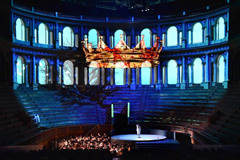| Opera Reviews | 3 May 2024 |
Parma's Teatro Farnese makes an impressive backdrop for Giovanna D'Arcoby Silvia Luraghi |
|
| Verdi: Giovanna D'Arco Festival Verdi 20 October 2016 |
|
|
It offers an impressive setting for opera, in spite of structural limitations (there is no orchestra pit, and in order to maximize seating space, the space for the orchestra remains quite limited), and the experience is embellished by the fact that members of the audience must go through the halls of the beautiful National Gallery to enter the theater. Normally, the audience would sit on the bleachers around the stage, but for this performance the stage was moved to the area in front of the main entrance, and a sloping parterre was placed in the hemicycle formed by the stalls. There was no space for the chorus on stage, so voices came from various directions around or on the side of the audience, while the orchestra was placed to the side of the small circular stage. Stage directors Saskia Boddeke and Peter Greenaway, helped by set designer Annette Mosk and especially video designer Peter Wilms, tried to make the most of the natural stage offered by the theater, with the wooden arcades on the background filled by portraits of Renaissance Madonnas, later turning into refugees, thus intending to set the action in the wider framework of religious wars. A blood shed gigantic crown materialized at different times, while Giovanna was constantly accompanied by two doubles, a peaceful and a bellicose one, who (quite redundantly) gave body to her inner strife. Very disturbing was the appearance of a cartoon like girls face blinking from behind the small arcades which should perhaps have represented Giovanna looking onto the action from the outside. In general, the directors’ intentions were not without interest, but all the various details together were simply too much, and the result was far from being compelling. On the musical side, Ramon Tebar conducted the chamber orchestra I Virtuosi Italiani correctly, but with little fire. Some moments were very compelling, such as the Finale 1, others less (the whole Prologue). Giovanna was Korean soprano Vittoria Yeo, who sounded somewhat uneasy in the dramatic parts. Tenor Luciano Ganci as Carlo also had a lyric voice that he needed to force a little for this role, and tended to sing everything forte, in spite of a nice timbre especially in the central register. Baritone Vittorio Vitelli as Giovanna’s father Giacomo was the most compelling member of the vocal cast. All three deserved more applause than they received from the rather tepid audience at the last performance.
|
|
| Text ©
Silvia Luraghi Photo © Festival Verdi |

 Parma’s Teatro Farnese is a baroque jewel. Built in the early 17th century, it enjoyed a short life: after its opening in 1628, it only hosted a handful of performances and was no longer used after 1732. It suffered bombing during the Second World War, when the wooden interior was completely destroyed by fire. The renovation took several decades, but in 2001 the theater finally reopened and was increasingly used until 2011, when it was included as a venue for the Festival Verdi, beside the more traditional Teatro Regio.
Parma’s Teatro Farnese is a baroque jewel. Built in the early 17th century, it enjoyed a short life: after its opening in 1628, it only hosted a handful of performances and was no longer used after 1732. It suffered bombing during the Second World War, when the wooden interior was completely destroyed by fire. The renovation took several decades, but in 2001 the theater finally reopened and was increasingly used until 2011, when it was included as a venue for the Festival Verdi, beside the more traditional Teatro Regio. 





